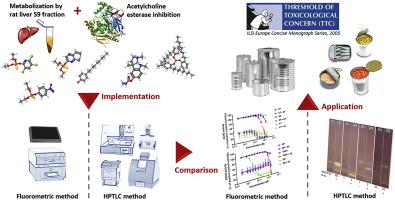当前位置:
X-MOL 学术
›
Anal. Chim. Acta
›
论文详情
Our official English website, www.x-mol.net, welcomes your
feedback! (Note: you will need to create a separate account there.)
New incorporation of the S9 metabolizing system into methods for detecting acetylcholinesterase inhibition
Analytica Chimica Acta ( IF 5.7 ) Pub Date : 2020-09-01 , DOI: 10.1016/j.aca.2020.06.033 Ebrahim Azadniya 1 , Julie Mollergues 2 , Thomas Stroheker 2 , Kathrin Billerbeck 1 , Gertrud E Morlock 1
Analytica Chimica Acta ( IF 5.7 ) Pub Date : 2020-09-01 , DOI: 10.1016/j.aca.2020.06.033 Ebrahim Azadniya 1 , Julie Mollergues 2 , Thomas Stroheker 2 , Kathrin Billerbeck 1 , Gertrud E Morlock 1
Affiliation

|
The activity of individual biotransformation products cannot be measured in multicomponent mixtures by the current status-quo assays. A prior separation and tedious isolation of compounds is required, and often in addition, a concentration step into a solvent suitable for the cell-/enzyme-based assay. Hence, the metabolizing S9 system, mimicking the complex biotransformation reactions in the liver, was aimed to be integrated into two orthogonal methods for analysis of the acetylcholinesterase (AChE) inhibition. For the microtiter plate assay method, the evaluation of the generated fluorescence signal was impaired by the incorporated S9 system. In contrast, the metabolic activator (S9 mixture) was successfully incorporated into the high-performance thin-layer chromatography (HPTLC) method. As proof of principle, four reference AChE inhibitors were studied in complex samples with and without metabolic activation. In addition to the neurotoxic carbamate eserine and the organophosphate insecticides chlorpyrifos, quinalphos and parathion, the tris(nonylphenyl) phosphite and nonylphenol, both originating from food contact materials, were tested in isolation but also in food packaging migrate and extract. A method comparison and benchmarking pointed to multifold advantages of using this newly developed bioanalytical tool for assessment of individual neurotoxins in complex samples. The sensitive HPTLC-S9-AChE assay allowed the detection of neurotoxic chemicals with and without metabolic activation, at levels consistent with the threshold of toxicological concern of organophosphates and carbamates. This new on surface metabolism system can be applied to other toxicities and samples.
中文翻译:

将 S9 代谢系统新纳入检测乙酰胆碱酯酶抑制的方法
目前的现状分析无法在多组分混合物中测量单个生物转化产物的活性。需要对化合物进行事先分离和繁琐的分离,而且通常还需要将浓缩步骤放入适用于基于细胞/酶的测定的溶剂中。因此,模拟肝脏中复杂生物转化反应的代谢 S9 系统旨在整合到两种正交方法中,以分析乙酰胆碱酯酶 (AChE) 抑制。对于微量滴定板测定方法,所产生的荧光信号的评估受到合并的 S9 系统的影响。相比之下,代谢活化剂(S9 混合物)成功地结合到高效薄层色谱 (HPTLC) 方法中。作为原理证明,在有和没有代谢激活的复杂样品中研究了四种参考 AChE 抑制剂。除了具有神经毒性的氨基甲酸酯丝氨酸和有机磷杀虫剂毒死蜱、喹诺磷和对硫磷之外,来自食品接触材料的亚磷酸三(壬基苯基)酯和壬基酚均进行了单独测试,同时也在食品包装中进行了迁移和提取测试。方法比较和基准测试表明,使用这种新开发的生物分析工具评估复杂样品中的单个神经毒素具有多重优势。灵敏的 HPTLC-S9-AChE 测定允许检测有和没有代谢激活的神经毒性化学物质,其水平与有机磷酸盐和氨基甲酸酯的毒理学关注阈值一致。
更新日期:2020-09-01
中文翻译:

将 S9 代谢系统新纳入检测乙酰胆碱酯酶抑制的方法
目前的现状分析无法在多组分混合物中测量单个生物转化产物的活性。需要对化合物进行事先分离和繁琐的分离,而且通常还需要将浓缩步骤放入适用于基于细胞/酶的测定的溶剂中。因此,模拟肝脏中复杂生物转化反应的代谢 S9 系统旨在整合到两种正交方法中,以分析乙酰胆碱酯酶 (AChE) 抑制。对于微量滴定板测定方法,所产生的荧光信号的评估受到合并的 S9 系统的影响。相比之下,代谢活化剂(S9 混合物)成功地结合到高效薄层色谱 (HPTLC) 方法中。作为原理证明,在有和没有代谢激活的复杂样品中研究了四种参考 AChE 抑制剂。除了具有神经毒性的氨基甲酸酯丝氨酸和有机磷杀虫剂毒死蜱、喹诺磷和对硫磷之外,来自食品接触材料的亚磷酸三(壬基苯基)酯和壬基酚均进行了单独测试,同时也在食品包装中进行了迁移和提取测试。方法比较和基准测试表明,使用这种新开发的生物分析工具评估复杂样品中的单个神经毒素具有多重优势。灵敏的 HPTLC-S9-AChE 测定允许检测有和没有代谢激活的神经毒性化学物质,其水平与有机磷酸盐和氨基甲酸酯的毒理学关注阈值一致。











































 京公网安备 11010802027423号
京公网安备 11010802027423号